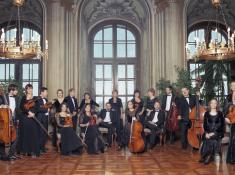
- More
- Performances
- Galleries
- Artists
Kristóf Baráti, violin
Mendelssohn Chamber Orchestra
PROGRAMME:
Felix Mendelssohn:
String Symphony No. 10 in B minor
Wolfgang Amadeus Mozart:
Violin Concerto No. 5 in A major, K 219
Allegro aperto
Adagio
Rondeau
Camille Saint-Saëns:
Introduction et Rondo capriccioso, op. 28
***
Béla Bartók:
Divertimento, Sz. 113
Allegro no troppo
Molto adagio
Allegro assai
Béla Bartók:
Romanian Folk Dances, Sz. 56
Bot tánc / Jocul cu bâtă
Brâul
Topogó / Pe loc
Bucsumí tánc / Buciumeana
Poarga Românească
Aprózó / Mărunțel
--
MORE ABOUT THE PROGRAMME:
Notes by Dina Puhovski
Felix Mendelssohn Bartholdy (Jacob Ludwig Felix M., Hamburg, 1809 – Leipzig, 1847) grew up in Berlin, where his mother regularly hosted salons. He played the piano, violin and viola and received lessons in composition since he was a boy. He attended Karl Zelter’s Sing-Akademie, where he later conducted a performance of the rediscovered St Mathew Passion by Johann Sebastian Bach – a composer whose works fascinated him – thus introducing the nineteenth-century audiences to the forgotten and, as was considered at the time, ‘difficult’ genius.
At the age of twelve, he met Goethe in Weimar, who compared him to Mozart and supported his composing. His work was influenced by his sister Fanny, also a composer, and his travels around Italy, England and Scotland. He served as music director in Düsseldorf and conductor at the Gewandhaus in Leipzig, where he was one of the founders of the Conservatory. Light, melodious and technically refined, Mendelssohn’s works include numerous piano pieces, symphonies, oratorios, the popular Violin Concerto, and Classical string quartets.
Between 1821 and 1823 Mendelssohn wrote 13 string symphonies, sinfonias, to be more precise, modelled after the works of his Classical predecessors, such as Haydn and Carl Philipp Emanuel Bach, under the mentorship of his teacher Carl Friedrich Zelter. He wrote String Symphony No. 10 (with first and second violas, an uncommon division) when he was fourteen. The symphony has only one movement, but it is unclear whether it was supposed to be an independent work, or the remaining movements were lost, as all his other symphonies consist of three movements. This youthful, classically structured piece already contains dramatic strokes typical of Mendelssohn’s later phases.
Franz Schubert once said that ‘a world that has produced a Mozart is a world worth saving.’ The Viennese genius, Wolfgang Amadeus Mozart (Salzburg, 1756 – Vienna, 1791) is probably one of the most highly regarded composers in history and most of the details from his biography are well known. He received his first musical training from his father, Leopold, gave public performances since he was five, toured extensively and was, allegedly, fond of easy living, which required a lot of hard work. It is known that the two Weber sisters played an important role in his private life, while the music patrons who commissioned new pieces from him were essential in his professional life. Best described as elegant and ‘deceptively easy’, Mozart’s music remains an inexhaustible source of inspiration. Tchaikovsky called him ‘musical Christ’, and Leonard Bernstein said that ‘it is hard to think of another composer who so perfectly marries form and passion.’ Mozart wrote symphonies, serenades, concertos, operas, Masses, the Requiem, as well as chamber music.
Mozart wrote most of his concertos for solo string instruments between 1773 and 1779, including the Violin Concerto No. 5 in A major, KV 219, written in 1775, shortly before his 20th birthday. He wrote violin concertos in Salzburg – where his family lived, which is why there are no letters about them to his family, unlike for many of his other works. He probably wrote the concertos for his own performance in the service of Prince-Archbishop Colloredo. Each of them is more extensive and complex than the previous one, and No. 5, the last in the series, is large and exceptionally technically demanding. Written in A major, a very important key to Mozart, it is one of the most performed violin concertos. With each Mozart’s concerto, the soloist becomes more and more important, and in the first movement of No. 5, everything stops to let in the soloist, who introduces his adagio into orchestral allegro. This is followed by a gentle, elaborate adagio with a singing violin part, and in the third movement, rondo, different atmospheres alternate – the main part is a minuet, but it includes a darker part with double basses playing arco al rovescio (with the wood of the bow), before the return of the lighter theme; the frenzied central part gave the concerto its nickname ‘Turkish’.
Camille Saint-Saëns (Paris, 1835 – Algiers, 1921) studied organ and composition at the Paris Conservatory, and unsuccessfully competed for the Prix de Rome grant. A frequent guest in music salons, he became a prominent figure of Parisian music life, known for his versatility and knowledge of mathematics, astronomy, ancient arts and science, and he also wrote a book of poems. He was renowned for his talent to read and play all the pieces from a list, improvise and remember the work played. He was an organist in numerous churches in Paris and a prolific composer, particularly inspired by Mozart, Beethoven and Schumann, who was still relatively unknown in France at the time. As a young composer, he wrote instrumental music, while his extremely successful opera Samson and Delilah was written much later. In 1870 he participated in the defence of Paris (in the Franco-Prussian War), but during the Paris Commune he fled to London, where he became a popular performer.
In the 1880s he was at the peak of his composing abilities, with Piano Concerto No. 5, Cello Concerto No. 2 and numerous chamber works. His later operas and other works are rarely performed today. For some time, he served as the President of the Société nationale de musique, which he founded, but was later taken over by D'Indy and the ‘Franckists’. Saint-Saëns was known for his disapproval of Debussy’s music and other, more ‘avant-garde’ tendencies, although many of his admirers, including Ravel, believed that Saint-Saëns’ music shared some characteristics with the music of those he opposed.
Saint-Saëns wrote Introduction in 1863 and dedicated it to the brilliant Spanish violinist Pablo de Sarasate, for whom he had already written a concerto. In the slow introduction (andante malincolico), the violinist has the opportunity for a display of expressiveness and elegance in a long melody with a sleepy atmosphere that slowly ‘awakens’, followed by a virtuosic and galloping rondo capriccioso with a Spanish-sounding theme. Sarasate often performed it, and both Bizet and Debussy wrote their own arrangements of this very popular piece.
After receiving first lessons from his pianist mother, Béla Bartók (Nagyszentmiklós, today Sannicolau Mare, 1881 – New York, 1945) studied piano and composition in Budapest. A skilled pianist, he made his debut at the age of twenty, in Budapest, where became a piano teacher. He soon devoted himself to collecting folk music, first in Hungary, then in other countries, often with Zoltán Kodály. Folk music strongly influenced his composing, through direct transfer or influence on his motifs, tonality, rhythm and melodies.
His early piece, Allegro barbaro, announced a specific new style, with piano virtually in the role of percussion; his one-act opera Duke Blubeard’s Castle introduced new colours and forms, and he was particularly prolific in the 1930s, when he composed works such as Mikrokosmos for piano, with specific Bulgarian rhythms and bitonality, and published the collected folk songs. The highlights of his chamber opus include string quartets – String Quartet No. 6, inspired by the disturbing events that shook Europe in 1939, was the last piece he wrote before immigrating to the USA in 1940. His later output returned to greater transparency and Classical models and his works became increasingly popular, making him one of the most performed composers of the 20th century.
Bartók’s Divertimento for string orchestra was commissioned by Paul Sacher, Swiss conductor and patron of the arts whose commissions yielded some hundred works. With Sacher providing him with a piano and a personal chef, Bartók composed the piece in only fifteen days, in August 1939, in the eve of turbulent events that changed the world, and it is one of the last works Bartók wrote before moving to the USA. Sacher commissioned a work that would be less complex (compared to some of Bartók’s previous works), and it does have a relatively ‘lighter’, neoclassical atmosphere, with a rich, rhythmic first movement, a darker second, reminiscent of his string quartets, and a rustic third.
Bartók collected Hungarian, Slovak and Romanian folk music, which he said strongly influenced his composing. Pianist and professor Stephen Strugnell believes that ‘Bartók was particularly drawn to Romanian folk traditions because he felt that these had been more isolated from outside influences and were therefore more authentic.’ Bartók’s research of Romanian idioms produced Romanian Folk Dances, his versions of the existing local dances. In Hungary and Romania, folk dances were usually performed in a sequence of five or seven dances, which is followed by Bartók. In 1915 he first compiled them into a piano suite dedicated to a teacher from Beius/Belényes who helped him collect the material. Two years later, he reworked the Suite for a smaller orchestra, while other versions came later.
Bartók followed the original dance sequence: The first, Dance with Sticks, is originally a solo dance for a young man; the second, Waistband Dance, is a circle dance emphasised with staccatos, in which dancers hold each other’s waists, and in the third, On the Spot, the couples dance on one spot. This is followed by a slower dance from the Buciumeni district, whose music shows clear oriental influences, Romanian Polka, a children’s dance with changing meters, and Fast Dance, in fact two, from the regions of Bihar and Torda, courting dances performed by couples in tiny steps.
--
Photo Kristóf Baráti (c) Marco Borggreve
--
--
- 10. August 2023./ Thursday / 21:30 Rector's Palace Atrium +Tickets



